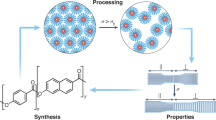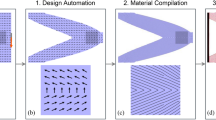Abstract
Natural composites are often heterogeneous to fulfil functional demands. Manufacturing analogous materials remains difficult, however, owing to the lack of adequate and easily accessible processing tools. Here, we report an additive manufacturing platform able to fabricate complex-shaped parts exhibiting bioinspired heterogeneous microstructures with locally tunable texture, composition and properties, as well as unprecedentedly high volume fractions of inorganic phase (up to 100%). The technology combines an aqueous-based slip-casting process with magnetically directed particle assembly to create programmed microstructural designs using anisotropic stiff platelets in a ceramic, metal or polymer functional matrix. Using quantitative tools to control the casting kinetics and the temporal pattern of the applied magnetic fields, we demonstrate that this approach is robust and can be exploited to design and fabricate heterogeneous composites with thus far inaccessible microstructures. Proof-of-concept examples include bulk composites with periodic patterns of microreinforcement orientation, and tooth-like bilayer parts with intricate shapes exhibiting site-specific composition and texture.
This is a preview of subscription content, access via your institution
Access options
Subscribe to this journal
Receive 12 print issues and online access
$259.00 per year
only $21.58 per issue
Buy this article
- Purchase on Springer Link
- Instant access to full article PDF
Prices may be subject to local taxes which are calculated during checkout




Similar content being viewed by others
Change history
10 November 2017
This Article has an addendum associated with it, for details see pdf.
References
Gibson, L. J., Ashby, M. F. & Harley, B. A. Cellular Materials in Nature and Medicine (Cambridge Univ. Press, 2010).
Aizenberg, J., Sundar, V. C., Yablon, A. D., Weaver, J. C. & Chen, G. Biological glass fibers: Correlation between optical and structural properties. Proc. Natl Acad. Sci. USA 101, 3358–3363 (2004).
Studart, A. R. Biological and bioinspired composites with spatially tunable heterogeneous architectures. Adv. Funct. Mater. 23, 4423–4436 (2013).
Wegst, U. G. K., Bai, H., Saiz, E., Tomsia, A. P. & Ritchie, R. O. Bioinspired structural materials. Nature Mater. 14, 23–36 (2014).
Meyers, M. A., McKittrick, J. & Chen, P.-Y. Structural biological materials: Critical mechanics-materials connections. Science 339, 773–779 (2013).
Dunlop, J. W. C. & Fratzl, P. Biological composites. Annu. Rev. Mater. Res. 40, 1–24 (2010).
Imbeni, V., Kruzic, J. J., Marshall, G. W., Marshall, S. J. & Ritchie, R. O. The dentin-enamel junction and the fracture of human teeth. Nature Mater. 4, 229–232 (2005).
Qi, H. J., Bruet, B. J. F., Palmer, J. S., Ortiz, C. & Boyce, M. C. Mechanics of Biological Tissue 189–203 (Springer, 2005).
Yang, W. et al. Natural flexible dermal armor. Adv. Mater. 25, 31–48 (2013).
Vincent, J. F. V. & Wegst, U. G. K. Design and mechanical properties of insect cuticle. Arthropod Struct. Dev. 33, 187–199 (2004).
Romano, P., Fabritius, H. & Raabe, D. The exoskeleton of the lobster Homarus americanus as an example of a smart anisotropic biological material. Acta Biomater. 3, 301–309 (2007).
Wilts, B. D., Whitney, H. M., Glover, B. J., Steiner, U. & Vignolini, S. Natural helicoidal structures: Morphology, self-assembly and optical properties. Mater. Today Proc. 1, 177–185 (2014).
Wagermaier, W. et al. Spiral twisting of fiber orientation inside bone lamellae. Biointerphases 1, 1–5 (2006).
Burgert, I. & Fratzl, P. Plants control the properties and actuation of their organs through the orientation of cellulose fibrils in their cell walls. Integr. Comput. Biol. 49, 69–79 (2009).
Meyers, M. A., Chen, P.-Y., Lopez, M. I., Seki, Y. & Lin, A. Y. M. Biological materials: A materials science approach. J. Mech. Behav. Biomed. Mater. 4, 626–657 (2011).
Currey, J. D. & Kohn, A. J. Fracture in the crossed-lamellar structure of Conus shells. J. Mater. Sci. 11, 1615–1623 (1976).
Amini, S. et al. Textured fluorapatite bonded to calcium sulphate strengthen stomatopod raptorial appendages. Nature Commun. 5, 3187–3199 (2014).
Maas, M. C. & Dumont, E. R. Built to last: The structure, function, and evolution of primate dental enamel. Evol. Anthropol. 8, 133–152 (1999).
Weaver, J. C. et al. The stomatopod dactyl club: A formidable damage-tolerant biological hammer. Science 336, 1275–1280 (2012).
Bentov, S. et al. Enamel-like apatite crown covering amorphous mineral in a crayfish mandible. Nature Commun. 3, 839–846 (2012).
Seabaugh, M. M., Kerscht, I. H. & Messing, G. L. Texture development by templated grain growth in liquid phase sintered alpha-alumina. J. Am. Ceram. Soc. 80, 1181–1188 (1997).
Libanori, R. et al. Stretchable heterogeneous composites with extreme mechanical gradients. Nature Commun. 3, 1265–1274 (2012).
Erb, R. M., Segmehl, J., Schaffner, M. & Studart, A. R. Temporal response of magnetically labeled platelets under dynamic magnetic fields. Soft Matter 9, 498–505 (2013).
Erb, R. M., Segmehl, J., Charilaou, M., Löffler, J. F. & Studart, A. R. Non-linear alignment dynamics in suspensions of platelets under rotating magnetic fields. Soft Matter 8, 7604–7609 (2012).
Sakka, Y. & Suzuki, T. S. Textured development of feeble magnetic ceramics by colloidal processing under high magnetic field. J. Ceram. Soc. Jpn 113, 26–36 (2005).
Sakka, Y., Suzuki, T. S., Tanabe, N., Asai, S. & Kitazawa, K. Alignment of titania whisker by colloidal filtration in a high magnetic field. Jpn. J. Appl. Phys. 41, 1416–1418 (2002).
Erb, R. M., Libanori, R., Rothfuchs, N. & Studart, A. R. Composites reinforced in three dimensions by using low magnetic fields. Science 335, 199–204 (2012).
Libanori, R., Erb, R. M. & Studart, A. R. Mechanics of platelet-reinforced composites assembled using mechanical and magnetic stimuli. ACS Appl. Mater. Interfaces 5, 10794–10805 (2013).
Erb, R. M., Sander, J. S., Grisch, R. & Studart, A. R. Self-shaping composites with programmable bioinspired microstructures. Nature Commun. 4, 1712 (2013).
Bouville, F., Maire, E. & Deville, S. Self-assembly of faceted particles triggered by a moving ice front. Langmuir 30, 8656–8663 (2014).
Hunger, P. M., Donius, A. E. & Wegst, U. G. K. Platelets self-assemble into porous nacre during freeze casting. J. Mech. Behav. Biomed. Mater. 19, 87–93 (2013).
Porter, M. M. et al. Magnetic freeze casting inspired by nature. Mater. Sci. Eng. A 556, 741–750 (2012).
Fukasawa, T., Deng, Z. Y., Ando, M., Ohji, T. & Goto, Y. Pore structure of porous ceramics synthesized from water-based slurry by freeze-dry process. J. Mater. Sci. 36, 2523–2527 (2001).
Deville, S., Saiz, E., Nalla, R. K. & Tomsia, A. P. Freezing as a path to build complex composites. Science 311, 515–518 (2006).
Munch, E. et al. Tough, bio-inspired hybrid materials. Science 322, 1516–1520 (2008).
Bouville, F. et al. Strong, tough and stiff bioinspired ceramics from brittle constituents. Nature Mater. 13, 508–514 (2014).
Walther, A. et al. Supramolecular control of stiffness and strength in lightweight high-performance nacre-mimetic paper with fire-shielding properties. Angew. Chem. Int. Ed. 49, 6448–6453 (2010).
Yao, H. B., Fang, H. Y., Tan, Z. H., Wu, L. H. & Yu, S. H. Biologically inspired, strong, transparent, and functional layered organic–inorganic hybrid films. Angew. Chem. Int. Ed. 49, 2140–2145 (2010).
Reed, J. S. Principles of Ceramic Processing (Wiley, 1995).
Lewis, J. A. Direct ink writing of 3D functional materials. Adv. Funct. Mater. 16, 2193–2204 (2006).
Studart, A. R. Towards high-performance bioinspired composites. Adv. Mater. 24, 5024–5044 (2012).
Bouville, F., Maire, E. & Deville, S. Lightweight and stiff cellular ceramic structures by ice templating. J. Mater. Res. 29, 175–181 (2014).
Studart, A. R., Filser, F., Kocher, P. & Gauckler, L. J. Fatigue of zirconia under cyclic loading in water and its implications for the design of dental bridges. Dent. Mater. 23, 106–114 (2007).
Ghielmetti, N. Enhancement of the Electron Collection Efficiency in Dye-Sensitized Solar Cells Master thesis, ETH Zürich (2011)
Launey, M. E. et al. Designing highly toughened hybrid composites through nature-inspired hierarchical complexity. Acta Mater. 57, 2919–2932 (2009).
Acknowledgements
We thank R. Libanori, D. Carnelli, N. Ghielmetti, J. Reuteler, B. Wegmann and P. Kocher for experimental assistance and discussions. We acknowledge internal funding from ETH Zürich and the Swiss National Science Foundation (grant 200020_146509), as well as support by the Center for Optical and Electron microscopy of ETH Zürich (ScopeM).
Author information
Authors and Affiliations
Contributions
Experiments were designed by H.L.F., F.B., T.P.N. and A.R.S., and conducted by H.L.F., F.B. and T.P.N. H.L.F. produced the scaffolds with controlled texture and composition and characterized the process and the products. F.B. prepared the nacre-like scaffolds (fully ceramic and with mineral bridges), performed the density control experiment and the mechanical characterization. T.P.N. did the polymer chemistry, the scaffold infiltration and the nacre-like copper composites. H.L.F., F.B. and T.P.N. designed the figures and the Supplementary Information, and A.R.S. wrote the main paper. All authors discussed the results and their implications, and revised the manuscript at all stages.
Corresponding author
Ethics declarations
Competing interests
The authors declare no competing financial interests.
Supplementary information
Supplementary Information
Supplementary Information (PDF 4146 kb)
Supplementary Movie 1
Supplementary Movie 1 (MOV 1805 kb)
Supplementary Movie 2
Supplementary Movie 2 (MOV 17472 kb)
Rights and permissions
About this article
Cite this article
Le Ferrand, H., Bouville, F., Niebel, T. et al. Magnetically assisted slip casting of bioinspired heterogeneous composites. Nature Mater 14, 1172–1179 (2015). https://doi.org/10.1038/nmat4419
Received:
Accepted:
Published:
Issue Date:
DOI: https://doi.org/10.1038/nmat4419
This article is cited by
-
Iron oxide/CNT-based artificial nacre for electromagnetic interference shielding
Nano Research (2024)
-
Izod impact resistance of 3D printed discontinuous fibrous composites with Bouligand structure
NPG Asia Materials (2023)
-
Fabrication and Testing of Bioinspired Composites with Curved Multilayer Microstructures
JOM (2023)
-
Magnetically assisted drop-on-demand 3D printing of microstructured multimaterial composites
Nature Communications (2022)
-
Bioinspired Strategies for Excellent Mechanical Properties of Composites
Journal of Bionic Engineering (2022)



